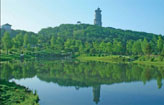Society
Luring shoppers, with clutter
Updated: 2011-04-24 08:04
By Stephanie Clifford (New York Times)
It turns out that lots and lots of stuff piled onto shelves or stacked in the middle of store aisles can coax a shopper to buy more.
After the recessionary years of shedding inventory and clearing store lanes for a cleaner, appealing look, retailers are reversing course and redesigning their spaces to add clutter.
Dollar General, an American retailer, is raising the height of its standard shelves to more than one-and-a-half meters; J.C. Penney is turning its empty walls into jewelry and accessory displays; Old Navy is adding lanes lined with water bottles, candy and lunchboxes; and Best Buy is testing wheeling in bigger items, like Segways and bicycles, to suck up the space created by thinner TVs and smaller speakers.
Wal-Mart Stores may provide the marquee example of a failed makeover. Two years ago, it remodeled, trying to hang on to Target shoppers who traded down to Wal-Mart during the recession.
Out went the pallets of items like juice boxes or sweatshirts stacked in the centers of aisles. Merchandise on "end caps," displays at the ends of aisles, slimmed down. Shelves got shorter, and Wal-Mart whittled the number of items it carried by about 9 percent, so as not to overwhelm shoppers. Customer satisfaction scores soared.
Despite those ratings, Wal-Mart has been encountering one of the longest slides in American same-store sales in its history.
"They loved the experience," William S. Simon, the chief executive of Wal-Mart's United States division, said. "They just bought less. And that generally is not a good long-term strategy."
So after remodeling a large percentage of its stores, Wal-Mart is now re-remodeling them, adding back inventory, plopping stuff into aisles and stacking shelves with a dizzying array of merchandise.
As it turns out, the messier and more confusing a store looks, the better the deals it projects.
"Historically, the more a store is packed, the more people think of it as value - just as when you walk into a store and there are fewer things on the floor, you tend to think they're expensive," said Paco Underhill, founder and chief executive of Envirosell, who studies shopper behavior.
Retailers are crowding shelves for a couple of strategic reasons.
After years of expansion, many retailers are halting building plans and closing stores as sales and traffic shift to the Web. That means the main way to increase revenue is by selling more stuff at the existing stores.
"All the retailers are stuck with less traffic going to the stores, and leases that are 15 to 20 years long," said Fiona Dias, executive vice president of strategy and marketing at GSI Commerce, which provides e-commerce technology for retailers like Toys "R" Us. "What do you do with all the extra space that you're paying for?"
Also, same-store sales are getting stronger, so retailers are adding back merchandise. At Wal-Mart, for instance, inventory at the end of January was 11 percent higher than a year earlier.
It is not just about what customers want but how they perceive a store. "Messiness, or pallets in the middle of an aisle, are also a cue for value," said Ben DiSanti, senior vice president of planning and perspectives for TPN, a retail marketing consultant.
"Whether they know it to be more of a discounter or not," he added, "if shoppers walk into a less organized environment, I'd bet their first impression is going to be, 'O.K., you're going to find lower prices here.'"
The New York Times
Specials

Urban breathing space
City park at heart of industrial hub positions itself as top tourism attraction

On a roll
Auto hub Changchun also sets its sight on taking lead in railway sector

The stage is set
The Edinburgh International Festival will have a Chinese flavor this year.